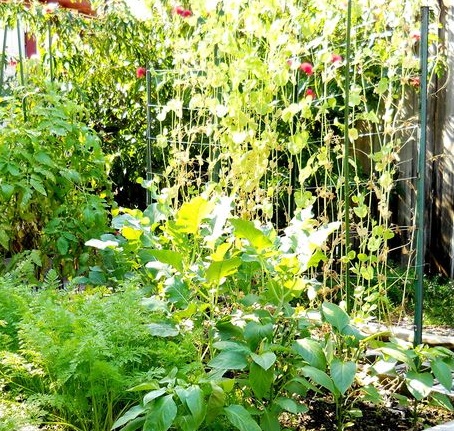
This post is more like an opinion piece, or as the newspapers used to call it, an editorial. That’s when they give you their opinion and cloak it as fact. Is Florida a perfect environment for growing vegetables?
About My Backyard
I live in the suburbs of Tampa. WOW! Central Florida! It’s a perfect place to be a vegetable gardener, right?? Well, not quite perfect, but yeah, pretty good. My backyard adds some location challenges all on its own too. Let me tell you about my backyard.
We Grow Veggies In The Winter And Spring
I used to get a lot of sun in this corner of my yard ten years ago. Today, not so much. The trees have grown larger, and do we have trees!!

We grow most in ground veggies in the winter and spring months, starting in late October. Funny thing though. They really don’t kick in until the end of December when the days start getting longer. Many if not most veggie plants are phototrophic. They grow lazy when days get shorter. They spring to new life after the solstice. We plant them earlier because they take a while to mature and set veggies. There are what is known as ‘short day’ veggies. It takes serious hunting around to find them, and then they are usually not heirloom seed stock.
Warm Weather VS Cool Weather Veggies
For a lot of the food plants I like to grow, they are done when the days get hotter. Things like lettuce and spinach either bolt (send up seed stalks) or get bitter when it gets warmer. I’m writing this in April and the lettuce is already getting bitter. The vegetables we grow are mostly up north cool weather crops. There are exceptions, of course, corn is one. Tomatoes and broccoli are not. There are some warm weather varieties that have been developed. They leave a lot to be desired though.
An exception to that is Brazilian broccoli. It is cross bred for heat tolerance. It does breed true, so it’s as good as any heirloom variety. That’s important to me. Instead of forming one large head, it has many side headlets and keeps on producing them all season long. If you are any kind of broccoli fan, you’re gonna love it! Even if you’re not such a big fan, this is the most delightfully tasty broccoli I have ever tasted.

Insects and Pest Control
One of the nice things about growing veggies in the wintertime here is the insect population is stifled. That’s beneficial, especially if you would prefer not to spray with commercial pesticides. I try to use more natural sprays, even making some of my own recipes. They work okay, sometimes. Even organic store bought sprays like Neem oil are of marginal efficacy. All of it washes off with watering or any amount of rain. Consequently, I’m spraying a lot. I also use a natural product known as Diatomaceous earth. It is silicon dioxide and comes from a type of algae fossil, no kidding. Here’s more info if you’re interested here’s a link:
http://npic.orst.edu/factsheets/degen.html. The Cliff’s Notes ver. is Diatomaceous earth has very sharp edges. When insects come in contact with it, their exoskeleton is scratched. They leak out all their innard juices and croak. Like most natural pest control, you must use it frequently to be effective. When it gets wet, even due to dew, it’s toast.
Shade Both Good And Bad
Now, my yard presents unique challenges. One of the reasons we bought this home was because of the beautiful live oak trees. Over the last twenty five years, they sure have grown! We have maintained them with professional trimming and deadwooding every couple of years. It has paid off with gorgeous large shade trees. One thing vegetables do not need is shade! Trust me. The difference from just 12 years ago is amazing when I compare my older veggie bed to the latest one. I have almost no direct sunlight on the garden bed this season. I do have a much lower electric bill in the summer though.
This year it’s been interesting to note that the winter sun dances across the sky along the perimeter of the shadiest part of the backyard. What luck! In the winter, the sun travels east southeast to the northwest. In the summer, it travels much more northeast to west. I get much more sunlight during the summer months when I don’t need it.
I have always grown a lot of ornamental plants all over the yard. The front yard is even shadier than the back. I grow full shade plants, like spathiphyllum (Peace Lilies) and many varieties of bromeliads. Ornamentals are much less demanding than veggies. In fact, if my plants just barely grow, I’m good. Not so much with food crops though.
It’s A Dirty Deal
My dirt is also challenging. I call it dirt because I’m hard pressed to call it soil. It’s mostly sand with a bit of organic material mixed in as an afterthought. There are two problems here; first, it ain’t all that fertile. Second, it holds water about a well as a strainer. This is why I grow food in large pots or special raised beds. The beds start with a special weed cloth base to hold in the water. I put in a combination of store bought top soil and home brewed compost on top of that. There’s a blog on how I make compost:
click on this link if you want to know more about making compost.
Close Enough To Perfect For Me
No yard is perfect. No garden is either. To paraphrase Donald Rumsfeld, ‘You garden with the yard you have, not the yard you might want. I grow crops with the yard I have and I’m happy with it. Count your blessings, I sure count mine!
